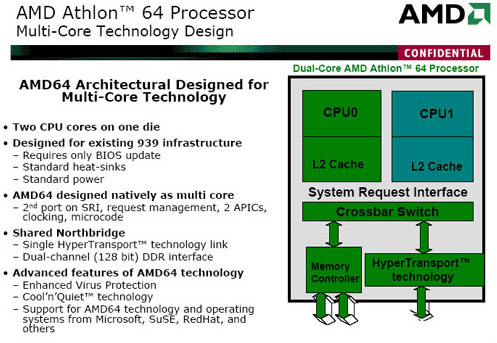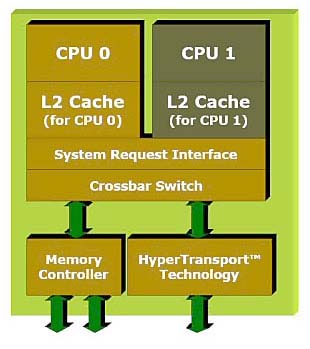The AMD Athlon 64 X2 3800+ Processor Review
Comparing the X2 to the Pentium D
Much has been made of dual core processors over the past 6 months. Unfortunately, unless you are multitasking or using one of a very few programs designed to take advantage of multi cored processors, you will not see much, if any, benefit to owning a dual core processor at this time. With dual core processors in their infancy, it is only common sense that it will take time for software developers and program writers to optimize their programs to use the full potential of these beasts. Right now, most of us will only see benefits from running multiple programs at one time (such as an anti virus or spyware app while playing a game, or encoding a video or burning a music CD while writing a review). However, it won’t be too much longer before we see some programs and games really take advantage of these new processors.

While Intel ran into some issues when it came to motherboard support for their Pentium D line (Intel’s still fairly new 915 and 925 chipset do not officially support dual core processors), AMD fans will be happy to know that if their socket 939 motherboard supports AMD’s FX 55, then it will gladly work with their new X2. The possibilities here are limitless: while the Pentium D is limited in support, owners have a bevy of PCI-E as well as AGP boards to choose from.


When it comes to thermal properties, the Pentium D again finds itself looking up at the X2. Although both are built upon a 90nm process, Intel’s Prescott 2 core (even with all its optimizations) is still an incredibly hot processor when compared to AMD’s X2. While the X2 3800 dissipates a managable 89W, the 2.8 Pentium D dissipated 95W. This is not a drastic difference, but something to keep in mind later when we get into testing and overclocking. On the flip side, AMD’s Athlon 64 X2 4800+, their high end X2 processor, dissipates 110W compared to Intel’s Pentium D 840 EE’s incredible 130+W. When it comes to managing the processor’s thermals, AMD not only has an obvious advantage in core design, but also their Cool and Quiet technology has been a very good performer by reducing the core speed to as low as 800MHz when the system doesn’t require extra power. Intel’s thermal management apps include EIST (Enhanced Intel SpeedStep technology), which allows the processor to adjust voltage and core frequency based upon system load. The caveat here is that Intel’s budget processor, the Pentium D 820, does not support EIST, as it is already running at Intel’s lowest possible frequency for this line, 2.8GHz.
When it comes to features and performance, both AMD and Intel show their muscle. Both the X2 3800+ and Pentium D 820 offer two cores, 64 bit OS support, SSE3, and noeXecute support to protect against most buffer overflow attacks. What I believe will end up giving the X2 a distinct advantage over the Pentium D is the X2’s on die memory controller, and the Pentium D’s lack of Hyper Threading (except with its 840 Extreme Edition processor).
Now that we know a little more about the processors both companies offer, lets see how they perform, and which might be best for your next system. From personal experience, I am really excited to have a go at the 3800+. Having owned quite a few AMD processors, I have found that their budget CPUs have ended up being a great choice for enthusiasts. While great performers at stock speed, they really show their benefit when in the hands of a person who knows how to tweak and manipulate extra performance out of them. The X2 3800+ should be no exception to this.

Comments are closed.